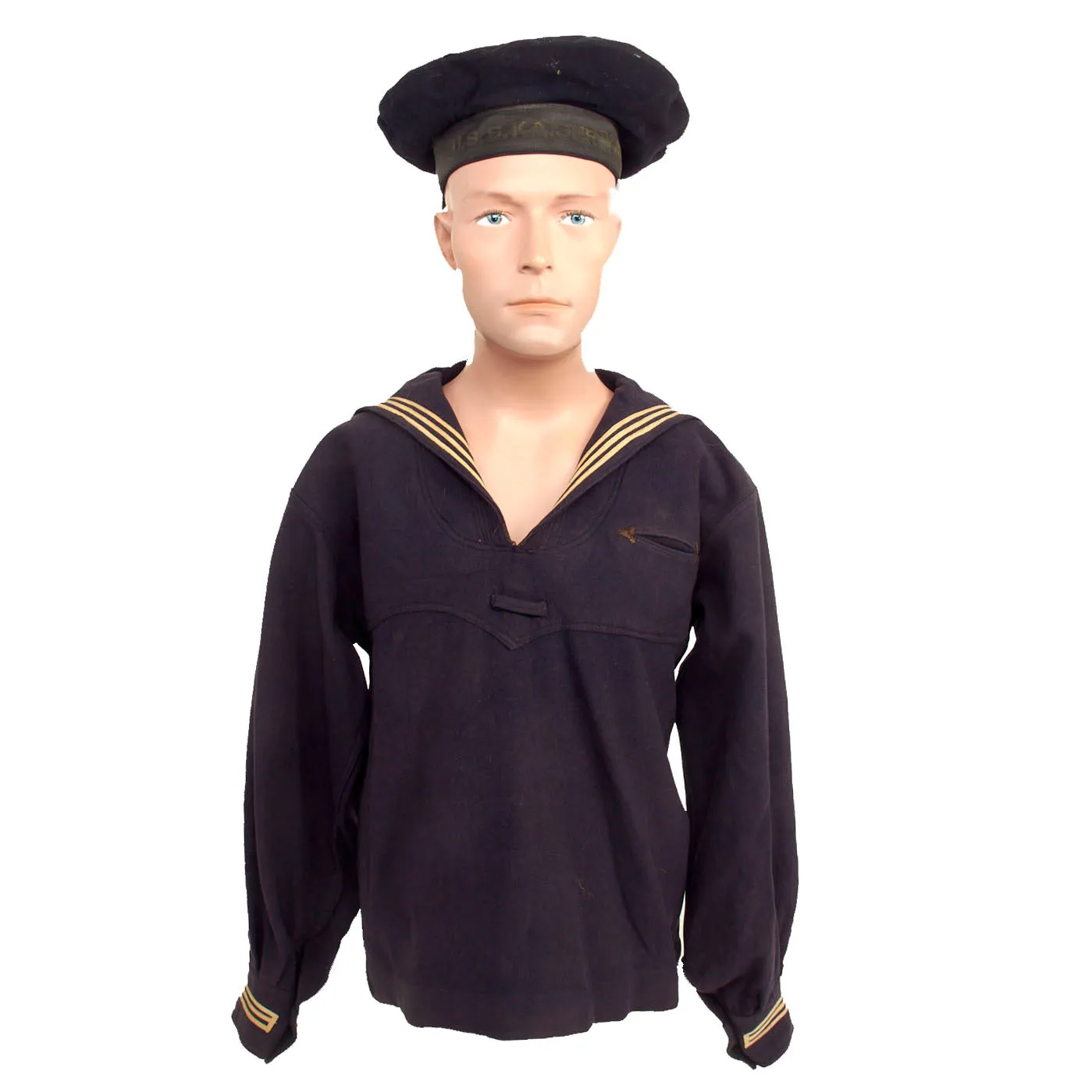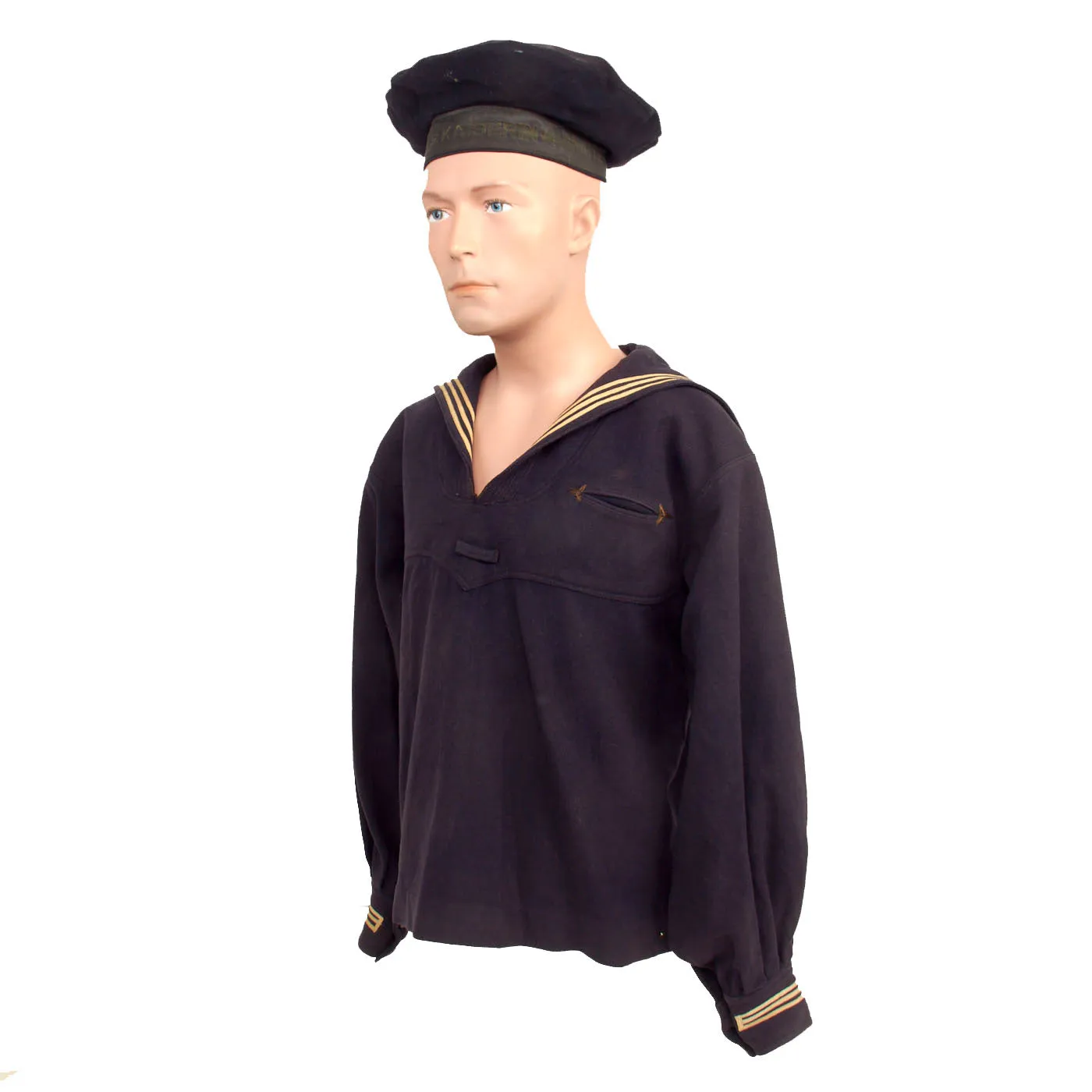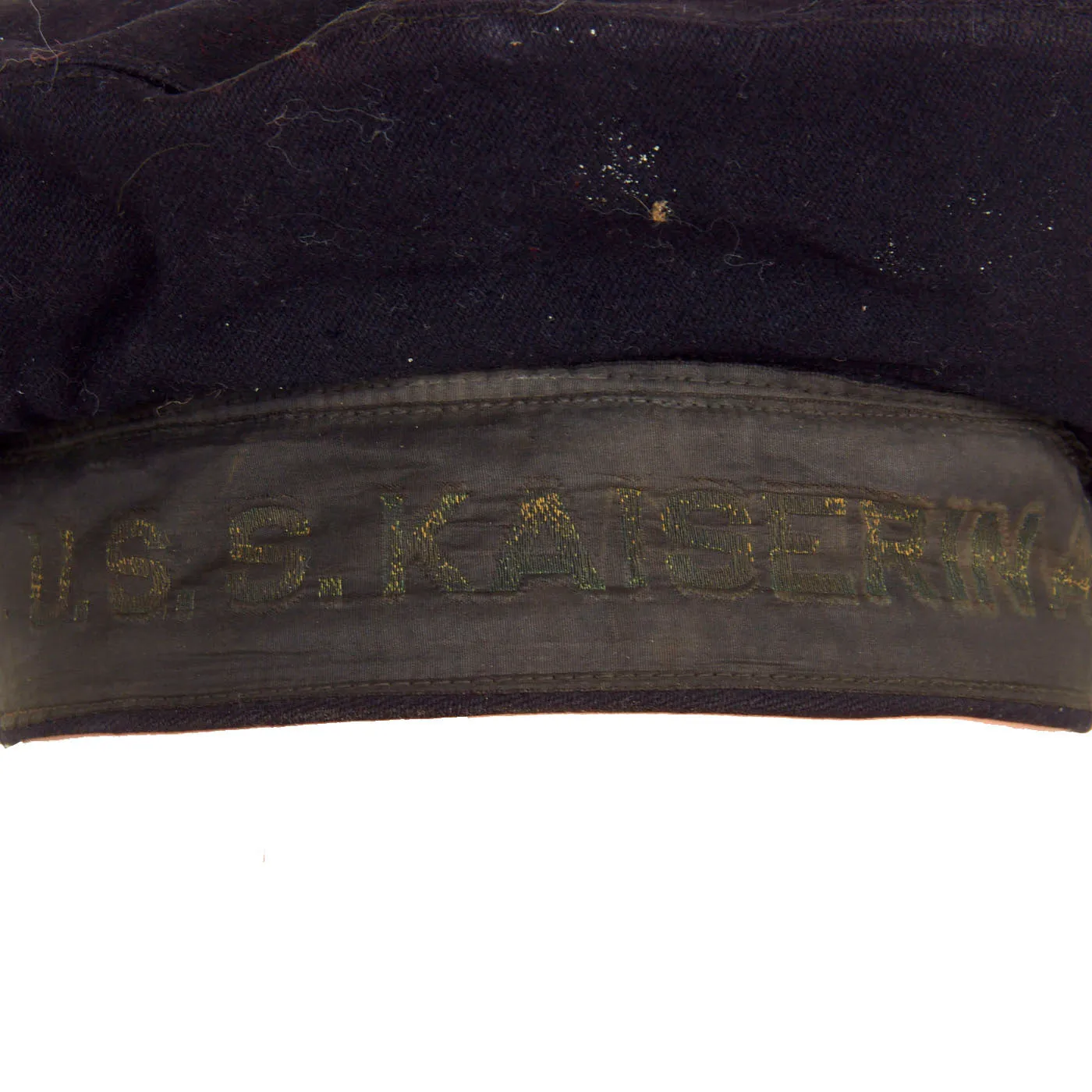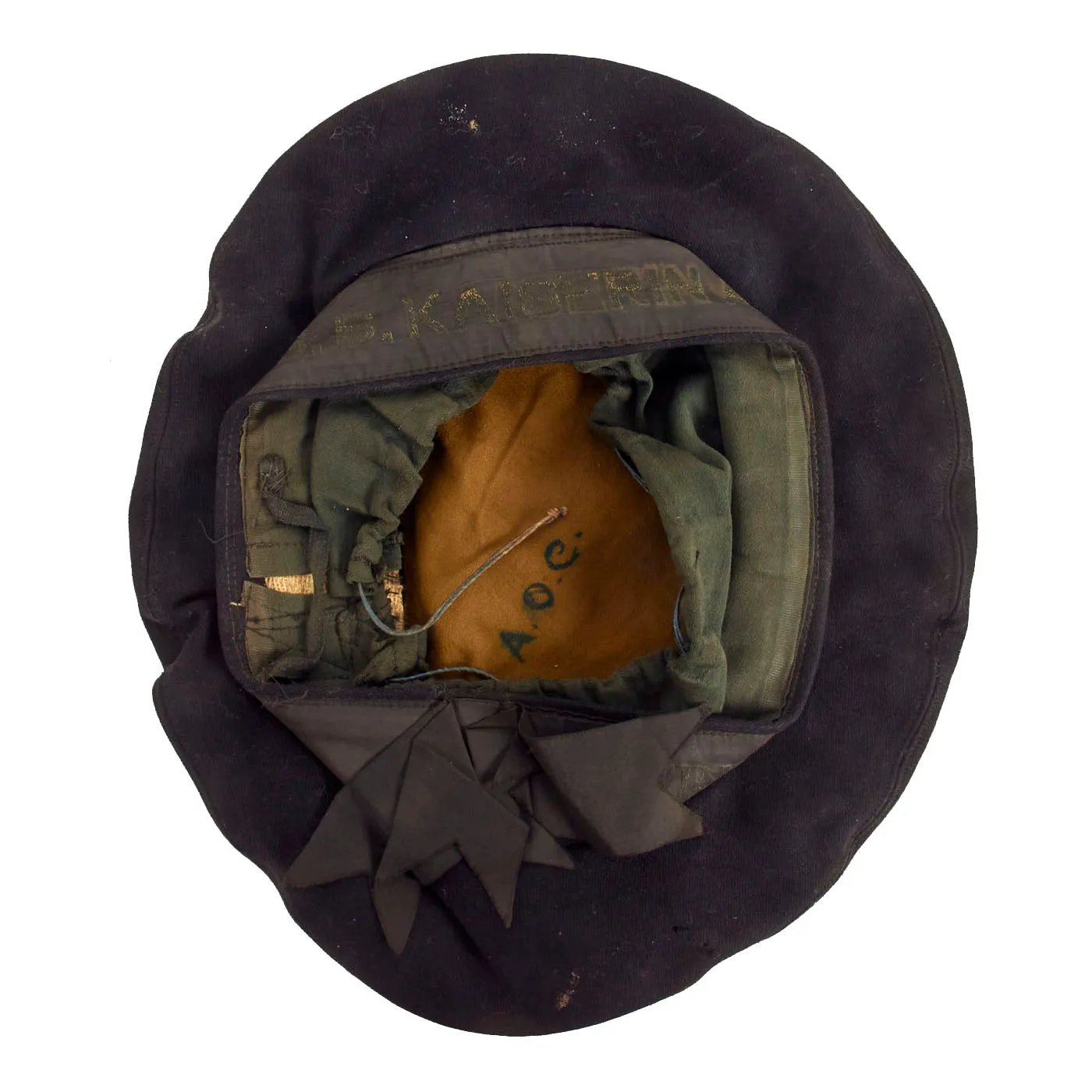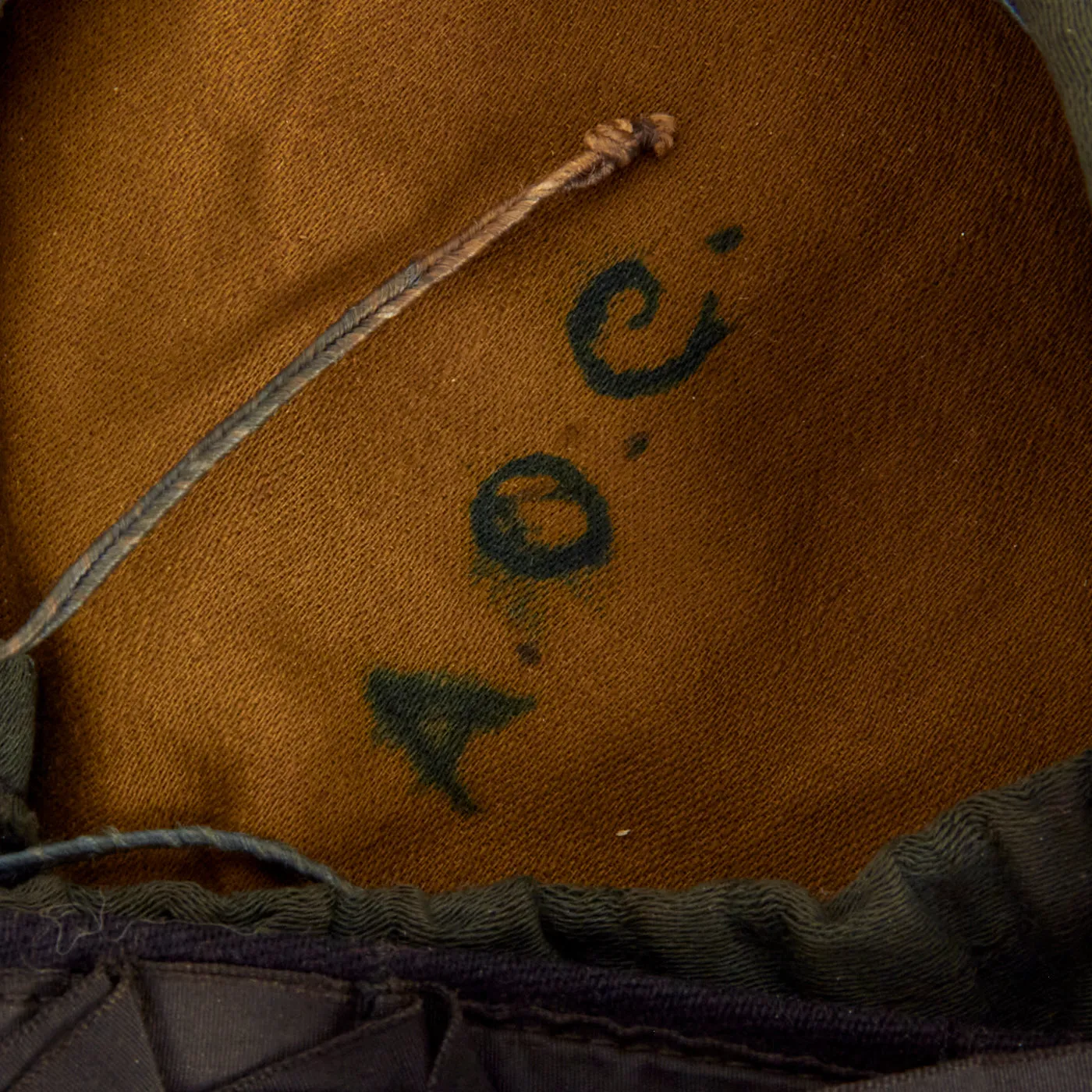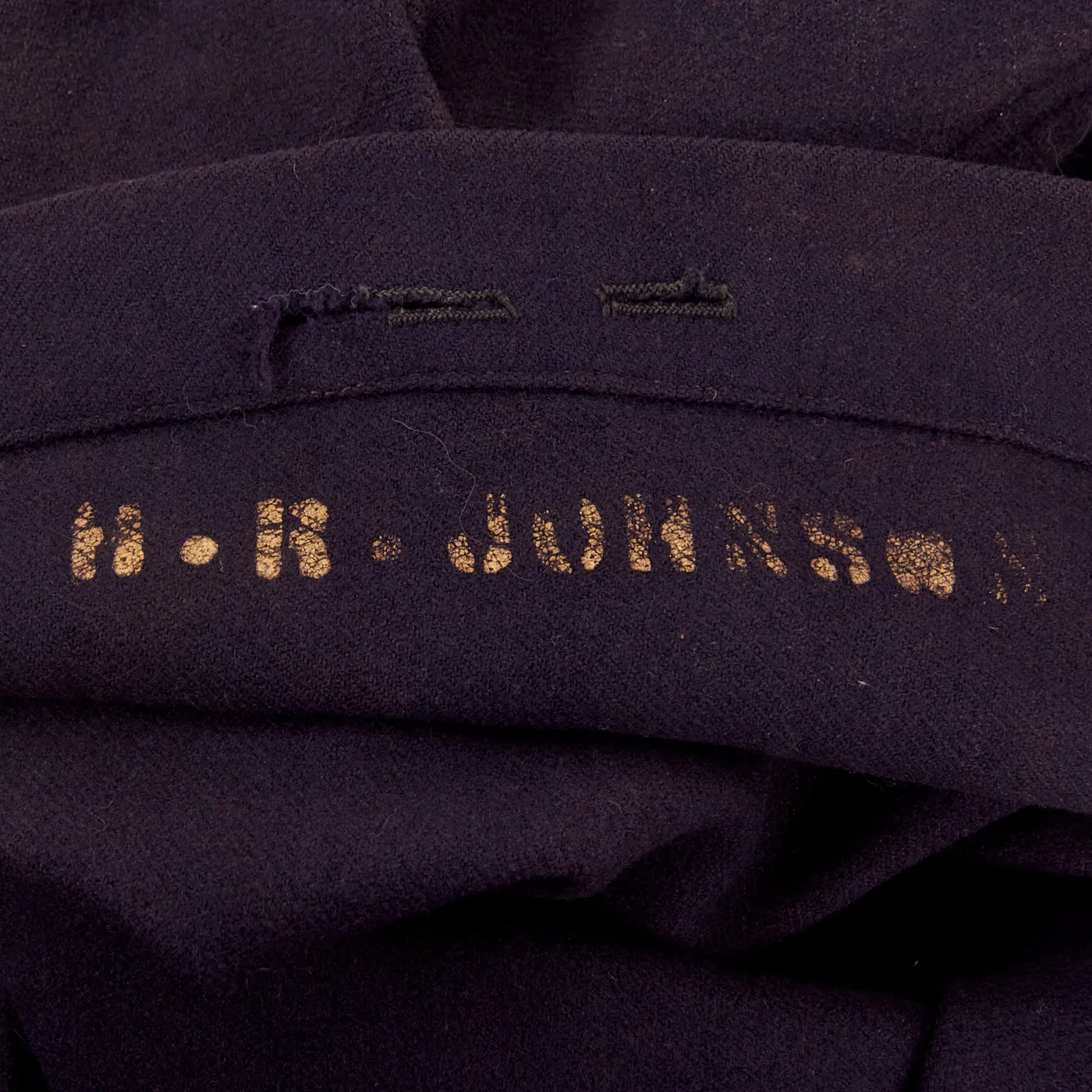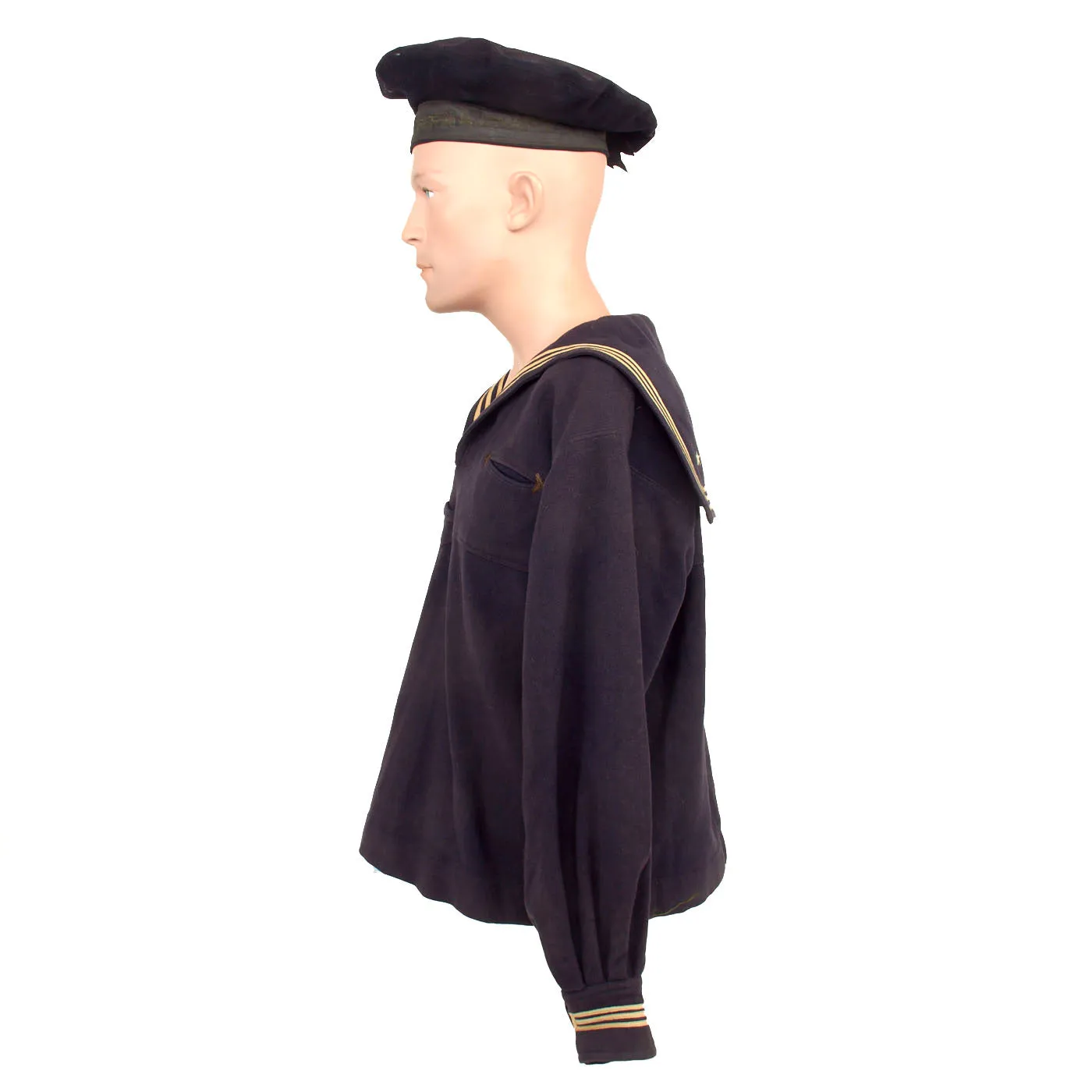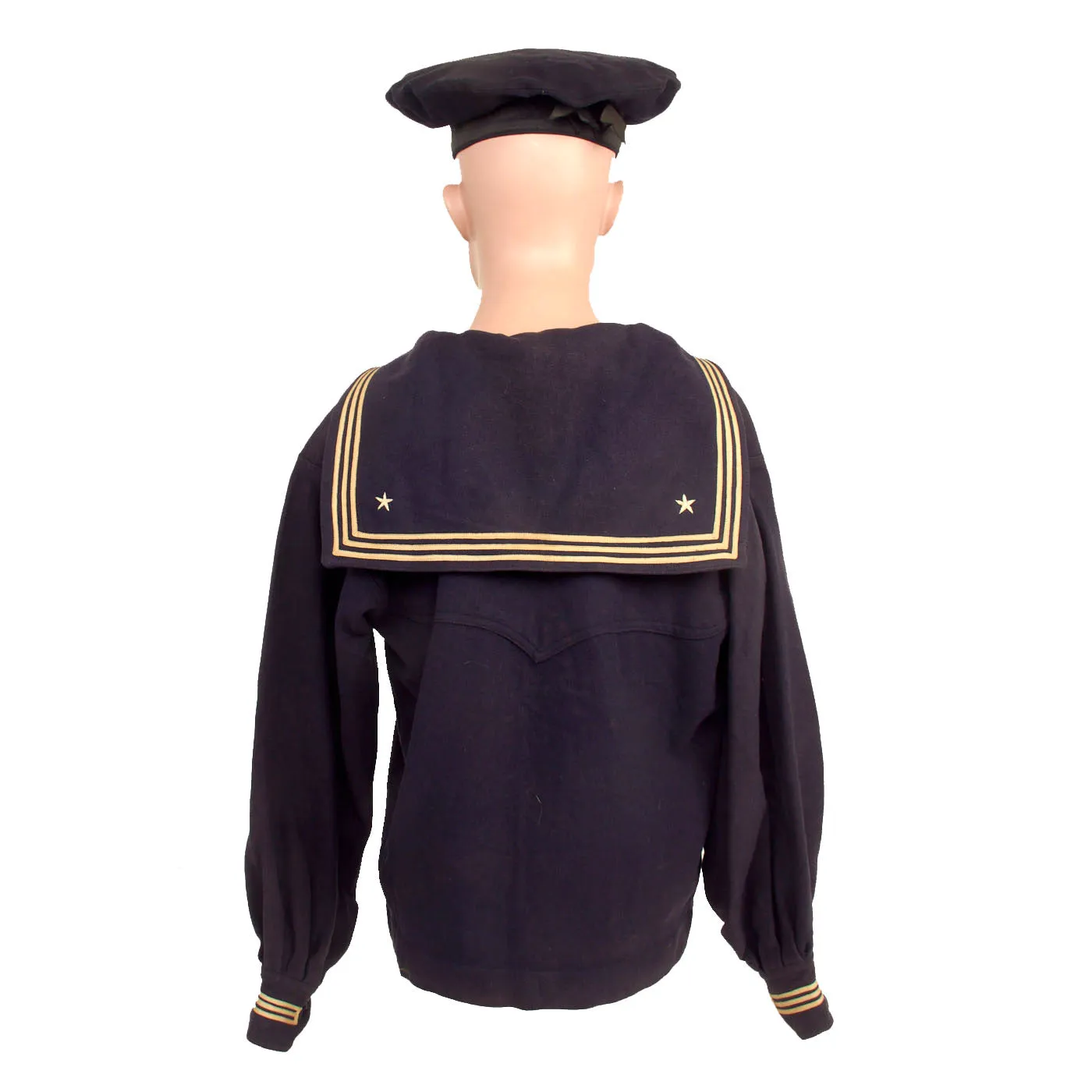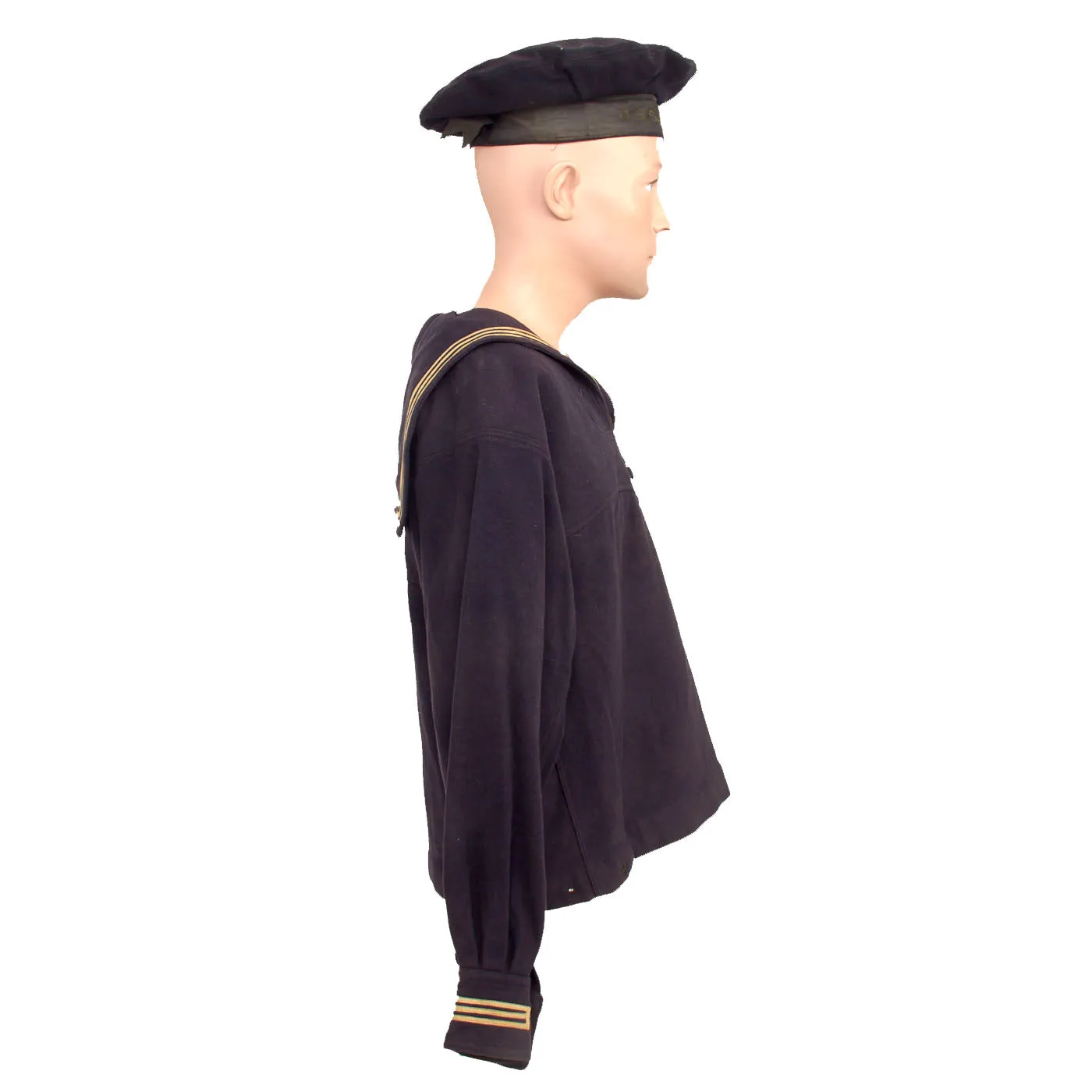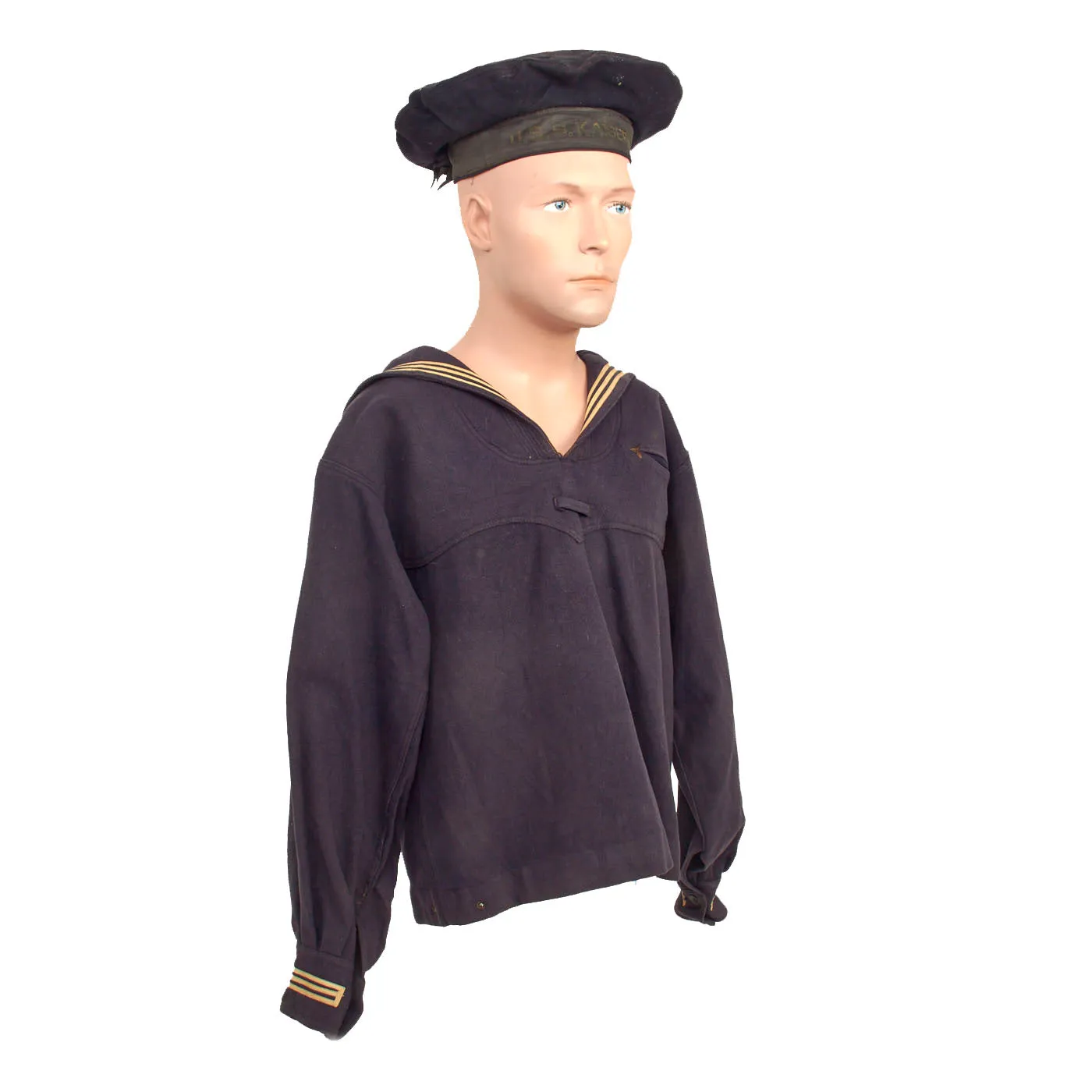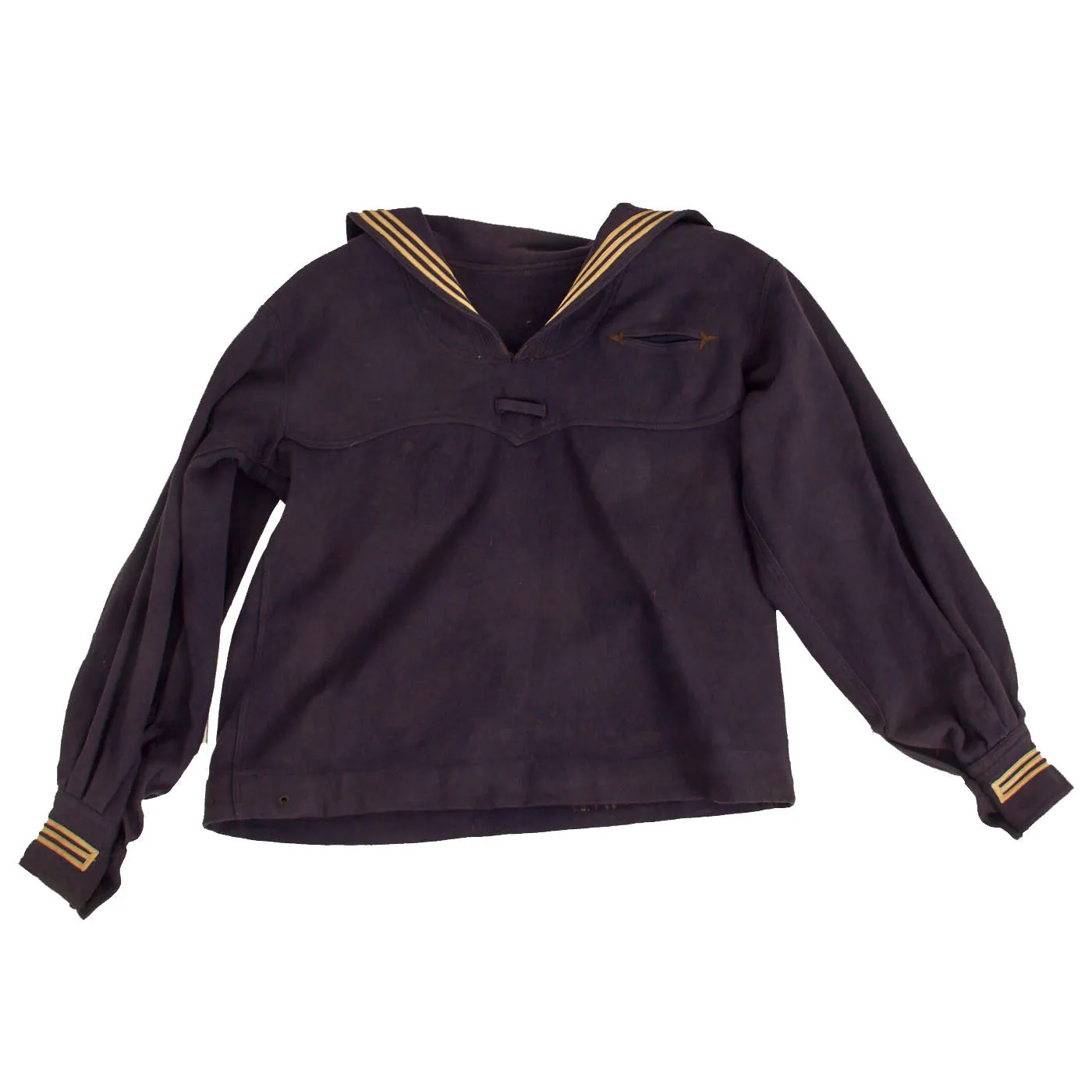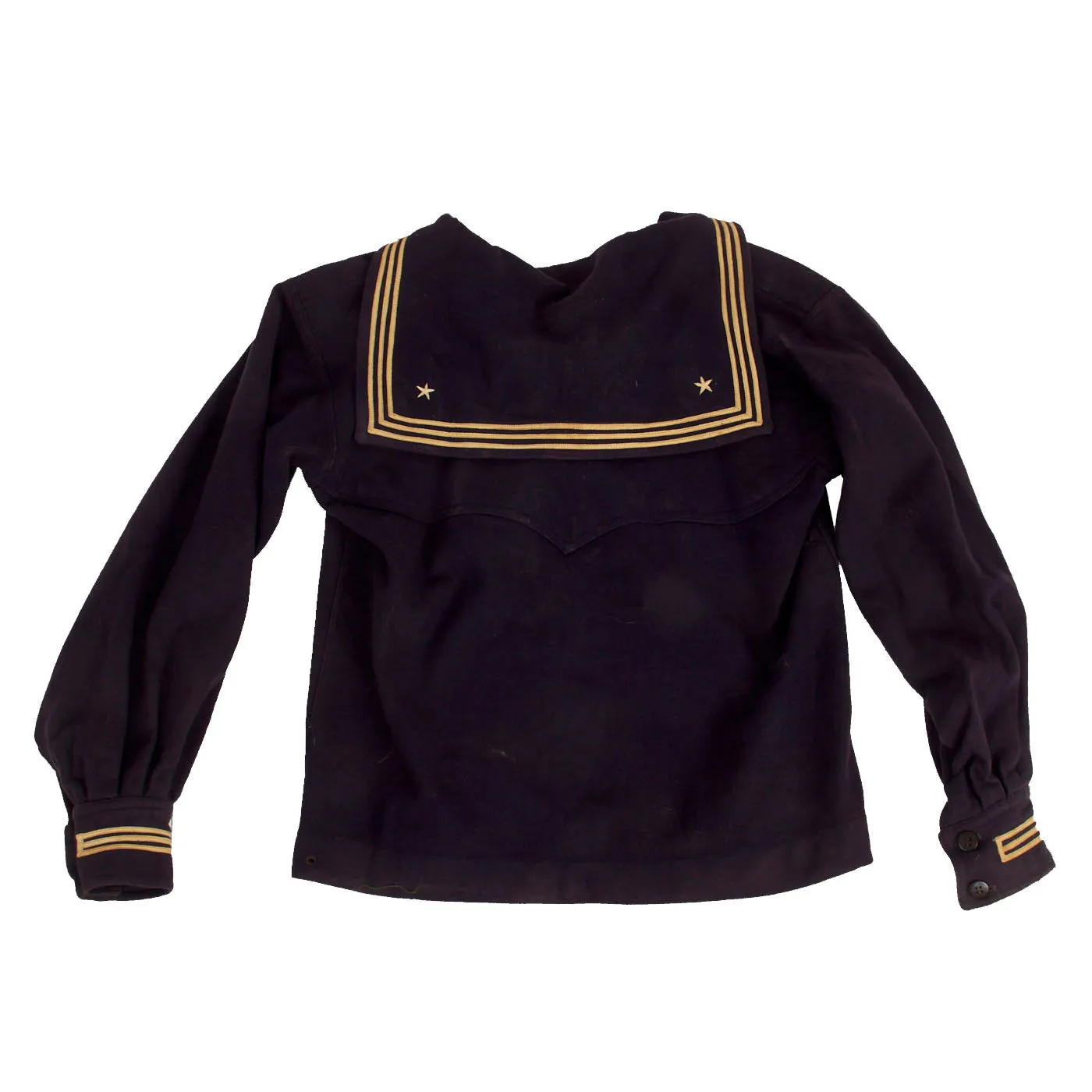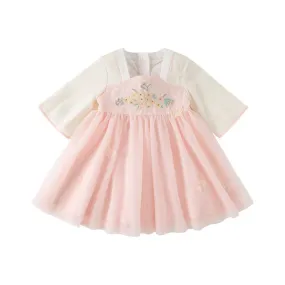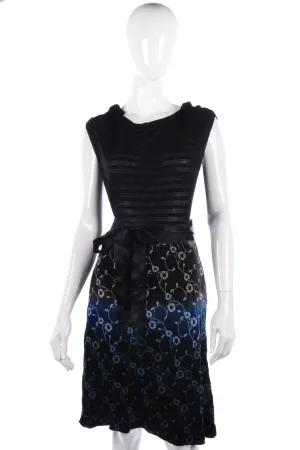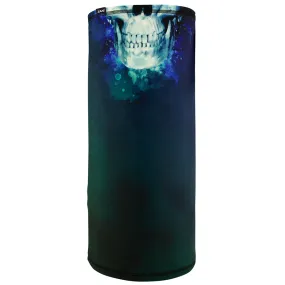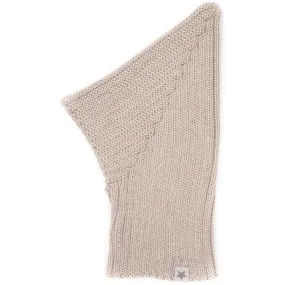Original Items: Only One Set Available. The US Navy dress blues have been in service for over 150 years and are still worn today. On a couple of occasions the Navy tried to replace the uniform. First, in the mid-40s, an "Ike" style uniform featuring a short jacket was tried out and was soundly rejected after its trial period. Then, between 1973 and 1980 the uniform was, in fact, briefly replaced with a more contemporary suit and visor cap design only to return to the tried-and-true dress blues. The uniform's main qualities of comfort, practicality, and a distinctive design have endeared it to the sailor. Iconic in appearance, the primary WW2 dress blue outfit consisted of a beret style cap with a ribbon and bow around the band; a "V" neck jumper with a square sailor's collar; a silk neckerchief; and bellbottom trousers with a 13-button broadfall front. Although its design features evolved from needs that had long since passed into history and were archaic even by WW2 standards, the uniform provided the sailor with an instantly recognizable uniform that boosted morale, evoked esprit de corps, and honored the Navy's proud history.
Photos dating back to at least the early 1860s show US sailors wearing a blue wool uniform not too different from the WW2 design. Through much of its early years the uniform was worn at sea, but by WW2 it had become mainly a dress uniform used for more formal occasions such as in formations, ceremonial activities, or for special guard duty. It was also worn on shore leave in appropriate climates. In fact, during WW2 it is most often seen being worn in northern shore and training stations by new recruits. The shift from a practical working uniform to one used for dress occasions was inevitable as military doctrine was evolving during the 1930s and 40s by setting specific roles for uniforms and establishing clear distinctions between work, garrison, and combat attire. And by the end of WW2 the age of multi-use uniforms had passed.
The dress blue jumper and trouser combination was considered a winter uniform to be worn in cool temperatures. It was constructed of high quality 16-ounce Melton wool that had a fine nap and was relatively soft to the touch. There were appropriate accessories to keep sailors warm on colder days. These included an overcoat made of matching heavy-weight Melton, blue wool knit gloves, and a blue wool muffler. The Dress Blue Uniform was included as part of the enlisted man's initial clothing gratuity. In northern training stations it was issued at induction and in warmer areas not until graduation was complete and final assignment received.
The dress blue uniform underwent continuous refinement over the decades of its use as was typically the case with uniforms that existed for any length of time. This process continued during WW2 with some significant changes being made to the jumper and trousers at the end of 1943. At this time it was decided to shorten the length of the jumper by six inches and simplify the waistband area of the trousers. These changes were implemented primarily to realize savings in a wartime economy by reducing the amount of fabric required to make the uniform and to speed up production by simplifying the manufacturing process.
Service Dress Blues for male junior enlisted sailors are based on the classic sailor suit in navy blue, colloquially referred to as "crackerjacks" because of the sailor-suited figure that adorns the packaging of Cracker Jack snacks. It consists of a navy blue wool pullover jumper with an elongated "tar-flap" collar adorned with three rows of white stripes and two white stars, one at each corner of the collar. The jumper's cuffs are similarly adorned with white stripes. A black silk or synthetic fiber neckerchief, rolled diagonally, is worn around the neck, under the collar, with the ends tied in a square knot in the center of the chest. The trousers for the uniform are flared as "bell bottoms". The trousers have traditionally featured a broad-fall opening, though changes to the trousers announced in 2012 have added a zippered fly, rendering the buttons merely decorative.
The jumper is plain and does not have any rating or specialty patches present. It is in lovely condition with minor moth mips present and no significant damage. The bottom inside waistline has the name H.R. JOHNSON present. Due to how common this name is, it is rather difficult to locate any solid service information, making for a wonderful research opportunity.
The blue cloth cap was remarkable for its longevity having served as an essential part of the enlisted sailor's uniform for over one hundred years. During its considerable time in service, the blue cap sailed on frigates, sloops, paddle wheels, submarines, battleships, and aircraft carriers. It was present for the transition from sails to steam to fuel oil, and even lived to see the advent of nuclear propulsion. But perhaps, most of all, the cap brings back memories of great armadas, the age of Dreadnoughts, and the historic conflicts they partook in.
Recorded in the Navy Uniform Regulations as early as 1833, the blue cap was originally part of an ensemble of clothing prescribed for enlisted seamen to be worn outdoors in both cold and warm weather. Early regulations simply described a "Blue Cloth Cap" until the Civil War period when the wording was slightly changed to "Blue Cloth Cap, without visor".
The circumference of the pre-1933 cap was much larger and required a wire stiffener on the inside to help keep its shape. Just like a lot of other sailors, the stiffener was removed to attribute a saltier appearance. The 1933 cap had a front riser that lifted the crown well above the ribbon. Additionally, the crown of the 1933 cap was attached to the sides using a cord seam, which is not present on this one. Prior to 1941, the vessel's name or any one of a number of different shore station designations could be displayed on the ribbon. In this case it's the German seized Oceanliner U.S.S. Kaiserin Auguste Victoria. The cap is in lovely condition and is even named on the inside with the initials A.O.C. written into the top lining. Unfortunately we have not been able to locate any service information, making for a wonderful research opportunity.
This is truly a wonderful set of an early US Navy Dress Blue Uniform with a ship tallied flat cap! Comes more than ready for research and display.
Approximate Measurements
Collar to shoulder: 10”
Shoulder to sleeve: 21”
Shoulder to shoulder: 19”
Chest width: 17”
Waist width: 18”
Hip width: 19”
Front length: 21"
U.S.S. Kaiserin Auguste Victoria
RMS Empress of Scotland, originally SS Kaiserin Auguste Victoria, was an ocean liner built in 1905–1906 by Vulcan AG shipyard in Stettin (now Szczecin, Poland) for the Hamburg America Line. The ship regularly sailed between Hamburg and New York City until the outbreak of war in Europe in 1914. At the end of hostilities, re-flagged as USS Kaiserin Auguste Victoria, she transported American troops from Europe to the United States. For a brief time Cunard sailed the re-flagged ship between Liverpool and New York.
The ship was refitted for Canadian Pacific Steamships (CP) and in 1921, she was renamed Empress of Scotland—the first of two CP ships to bear that name.
The vessel ended service in 1930 and was sold for scrap. During the demolition of the ship, the vessel caught fire, broke in two and sank. The hulls were raised and scrapped.
Kaiserin Auguste Victoria was built by AG Vulcan Stettin in Stettin on the Baltic in 1905–1906. The new ship was ordered by the expanding Hamburg America Line. At 24,000 plus tons she was the largest passenger liner in the world from 1905 to 1907 until the advent of Cunard's Lusitania.
When the keel was laid down as "Ship #264," this vessel was intended to be named SS Europa; she was to have been a sister ship to SS Amerika which was being built by Harland and Wolff in Belfast during the same period. At the time of her launching on 29 August 1905, her only peer in size was the slightly smaller Amerika which had been launched days earlier.
German Empress Augusta Victoria of Schleswig-Holstein permitted the vessel to be named after her and participated in the launching ceremonies.
The 24,581-ton vessel had a length of 677.5 feet (206.5 m), and her beam was 77.3 feet (23.6 m). She had two funnels, four masts, twin propellers, and an average speed of 18 knots (33 km/h; 21 mph). The ocean liner provided accommodation for 472 first-class passengers and for 174 second class passengers. There was room for 212 third-class passengers and for 1,608 fourth-class passengers.
Kaiserin Auguste Victoria left Hamburg on 10 May 1906 on her maiden voyage to Dover, Cherbourg, and New York under the command of Captain Hans Ruser. Thereafter, she regularly sailed the route between Hamburg and New York.
In 1910 the ship was to be used in experiments for the world's first ship-to-shore airplane flights by pilot John McCurdy. A special platform was built on Kaiserin Auguste Victoria to provide a runway for McCurdy's plane. McCurdy abandoned the attempt when rival pilot Eugene Ely flew from the deck of USS Birmingham off Hampton Roads, Virginia in 1910. Kaiserin Auguste Victoria then returned to sailing on her regular schedule. A similar experiment using airplanes launched at sea to carry mail was carried out on SS Bremen twenty years later.
In June 1914, Kaiserin August Victoria made her last voyage under a German flag, sailing from Hamburg to Southampton, Cherbourg, and New York, and returning to Hamburg.
During World War I, Kaiserin Auguste Victoria stayed in the port of Hamburg starting in August 1914. In March 1919, she was surrendered to Britain. The ship was chartered by the United States Shipping Board, and USS Kaiserin Auguste Victoria carried American troops from France to the United States. The ship made five crossings bringing troops home from the war.




